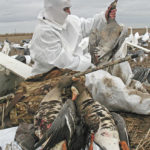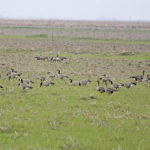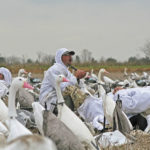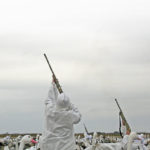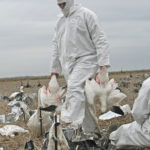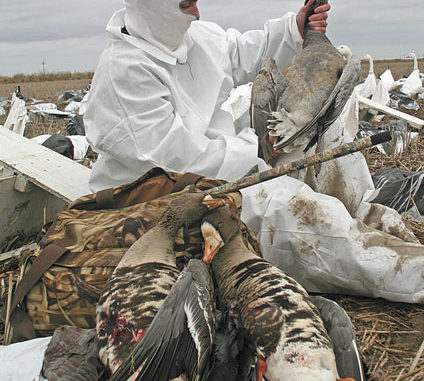
Changing farming practices are dramatically altering goose hunting in Southwest Louisiana.
The inky black predawn ride to the field where Clint Mathews and his crew of guides set out a decoy spread of several thousand rags, shells, full bodies, kites and every other trick — past and present — known to the goose hunting world was notably longer than usual as last year’s specklebelly season wound down.
Anticipation was still high with the prospects of actually being a decoy in the spread, especially with the distinct possibility of a few lesser Canada geese, provincially know as “cacklers.” The succulent little black-footed birds mainly occupy a small stretch of land around Klondike and Lake Arthur, well west of Mathews’ traditional stomping grounds around Kaplan.
“We’ve got a chance to get a few of them,” said Mathews (337 652-4245). “They’re fun little birds to work and give us a little change of pace. Some of these guys on the hunt today want a few of every species to mount.”
There’s something amiss among the goose-hunting crowd in the southwestern part of the state. All species of geese, from the huge numbers of bafflingly shy light geese — blues and snows — to the more cooperative and much better-tasting specks, are behaving differently. The numbers, according to most, are stable. The behavior — and its effect on those who pursue them — is giving many hunters pause.
“It could be a lot of things. We’ve had a whole lot go on the past couple of years,” said Mark LaCroix of LaCroix’s Hunting Lodge (337 774-5553). “From the hurricanes to the new strains of rice to more efficient combines, the birds are working differently.”
One explanation for the somewhat disturbing lack of birds in fields that have traditionally been consistent producers is a different brand of rice. Mathews points to the rice industry’s attempts at making it in the challenging farming industry.
“In a lot of the fields, you just don’t see any evidence of the birds rooting around,” he said. “In years past, you’d see fields that were just pigpens. The geese would get in there — especially the snows and blues in the those gigantic flights — and turn over the soil to get to the roots of the leftover rice stubble. They’d just lay waste to the field, and then move on.”
Mathews says an experiment by a group on some rice property might have literally soured the taste of the soil on the big, noisy birds.
Mathews says the strain — known as Clearfield 131, 151 and 161 — is non-discernable to humans, so it’s been taking off like wildfire in an effort to take out the pesky weeds that compete for the rice’s territory.
“It’s becoming more and more popular every year,” he said. “Especially for the light geese — the snows, blues and Ross’ — they really like to root around. That’s not taking place at all in the fields we’re talking about.”
We pulled into LaCroix’s property, and tried to ignore the lack of a breeze as hard we tried not letting the hordes of mosquitoes in the truck. Mathews’ group of guides had reported, among the absolute mandate to bring bug spray and plenty of it, waking and running off a group of geese in the decoys when they arrived — some of the spread was deployed the evening before — and the air was alive with the unmistakable sound of snows, blues and specklebellies as the gameplan was given to the party and everyone donned white suits.
Mathews and LaCroix frequently work together in accommodating large and small groups. Mathews sends small groups wanting a pit blind to LaCroix and LaCroix returns the favor in kind in recommending large groups interested in large rag spreads.
This morning, however, there was a matter of simply giving Mathews’ party a chance at a good hunt.
“The birds have been extra fickle this year in terms of using certain fields,” Mathews said. “We had two great hunts last weekend, and I checked that field all this past week. On Monday, there were fewer birds, Tuesday was worse and on Wednesday they were all gone.
“None of the other fields that I lease around Kaplan had any birds of any numbers, so we had to find some. The good thing about Mark’s fields are that there have been a good number of Canadas in the area. And we’ve got a large body of birds to the south and smaller bodies almost all around us.”
Scott Trahan of G&H Seed in Kaplan explained that research designed at making things easier for rice farmers has come across a relatively new product designed by the LSU Ag Center and Horizon Seed.
“What they did was basically the same thing that happened with soybeans — the Roundup-ready beans — and their ability to pretty much eliminate any other plant besides the beans,” said Trahan. “The Clearfield strain of rice takes out the red rice and the black rice, two kinds of wild rice. It also eliminates a lot of other plants, but those are the main targets.”
Several reasons exist for the use of such herbicides, which has increased in penetration in the Kaplan area to around 65 percent in 2008 among the 30,000 acres of rice planted to an expected 70 to 75 percent for the 2009 crop.
“No. 1, a clean field makes it easier for the farmer to harvest,” Trahan said. “Two, having the red and black rice in the sample takes away from the grade, which sets the price. And then, of course, the rice is not competing with everything else around it for the nutrients in the soil.”
Trahan says that though the growth of popularity in the Clearfield brand is steady, he doubts it will ever reach 100 percent.
“Pretty simply, there are some fields that for whatever reason don’t have a problem with red and black rice,” he said. “They don’t have a problem with their grade or they’re happy with the grade they’re getting with the product they’re using.”
But, still, a lot of farmers are using the Clearfield strain.
“These guys found a formula for herbicide-proof rice,” Mathews said. “All of the wild rice and other plants — the red and black rice and everything else around — died. The rice developed a resistance to anything they’ve got out there right now.”
So farmers are able to douse their fields planted with the Clearfield strain with herbicides. All of the naturally growing plants, the wild rice, indigo, alligator weed, bird-eye, were eliminated. The existence of large doses of herbicide in the soil, while not having long-lasting effects to crop production, has prevented geese from feeding on the root systems. So they’re staying in fields for shorter periods of time, making keeping track of them more difficult for men like Mathews.
What remains puzzling to Mathews and LaCroix is the geese’s hesitance to even go to the trouble of eating some of the new strains of rice in certain fields.
“I’ve got a field that in years past has been a consistent producer all season long,” Mathews said. “We don’t hunt it all season, but the birds would use it and there was enough feed in there to support it all year.
“This year, they wouldn’t eat the rice off of the stalk. They can reach it and they’ve done it before, but that field — it’s 400, 500 acres of a second crop of rice — gives me an idea that maybe it’s got a bad taste or something.
“There are cases where big groups of geese will make their way into a new field, fields that have traditionally held geese for weeks at a time, and will remain there until the field is just one big mudhole in the end. They’ve turned over the soil trying to get every morsel it seems, and the birds have left it after three or four hours and never come back.”
Dawn broke balmy, still and buzzy from the mosquitoes that obviously agreed with 13 humans averaging 200 pounds in the field. Group after group of specks and snows bypassed the laconic spread in favor of livelier pastures. But there were enough singles and pairs filtering in to give the hunters good action. And a beautiful pair of Ross’ geese worked perfectly, as did an immature blue and a mature snow in addition to the mix of specklebellies, both barren youngsters and heavily barred vets.
“We’re at war with the weather every day,” said LaCroix, as he took in the scene of another quartet of specks that eyed the 2,000 decoys carefully before losing interest about 100 yards from shooting range. “There are some things you just really need on most all days for duck and goose hunting to work. Wind is one of those things. It’s supposed to pick up ahead of this little front, but the weathermen didn’t really have any idea when that was going to be. Every few hours for the past few days they’ve changed the wind and the direction it’s supposed to come from.”
The lesser Canadas that the area is known for didn’t materialize except on the ride home, where the stately birds mixed in with specks.
“That’s too bad. When they’re in the area, they’re either locked in to a spread or not. I’d like to say that calling is important, but they’re funny little birds. When they see something they like, nothing much is going to stop them,” said Mathews as I snapped pictures from the truck.
The first crop of rice generally goes in the field around March 15, and is harvested late July and early August. The second crop, which attracts and feeds the ducks and geese in the Acadian Prairie region, is planted around teal season (mid September) and harvested around the start of duck season in early to mid November.
“There are some fields that the birds just never get into,” said LaCroix. “Goose hunting has definitely gotten tougher. The combines just don’t leave a whole lot of leftover grain on the ground, the (2008) hurricanes beat down the second crop right when it was getting started, even some of it was damaged to where farmers couldn’t cut it.”
Crawfish farming, a nice side income for farmers seeking to maximize profits from their fields, has been lucrative for rice farmers, especially in early 2009 when wholesale pond crawfish were being sold for $2.50 per pound.
“It’s been tough to find crawfish this year. There’s a feeling that the fields that are loading up on herbicides to keep the wild rice and everything off are making it tough on the crawfish production,” said Mathews, who dabbles in crawfish farming in addition to his Kaplan-based heating and cooling business. “We’ve hardly ever gotten these kind of prices down here.”
